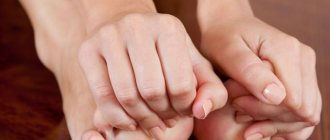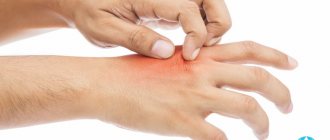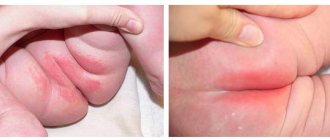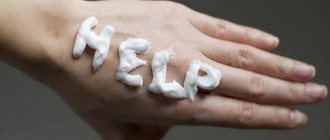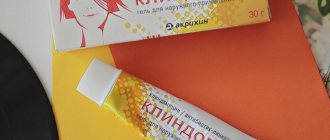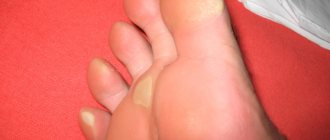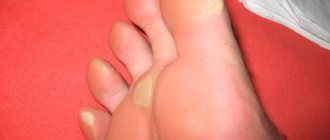The human body always tries to warn about the development of serious disorders in it by the appearance of visible signs indicating pathological changes in health. One of these first signs of illness is acne that covers the fingers of the upper extremities, palms and backs of the hands. Such pathological changes on the wrist should not be ignored, especially if the rash on the hands itches, crusts, bleeds or becomes infected with the appearance of purulent blisters.
Very often, a rash on the arm in the form of small pimples that itches is a signal of the development of a dermatological illness or disease of internal organs, which should not be ignored under any circumstances. Failure to see a doctor in a timely manner or a complete lack of medical care can lead to complex variants of the course of the underlying disease, complications of the pathological condition, and its transition to a chronic form.
Watery blisters on the skin of the hands: What is it?
Watery blisters on the hands are small formations protruding above the skin level, the diameter of which does not exceed half a centimeter. They differ from healthy skin in color and in most cases are red or pinkish in color. Inside, such rashes are filled with clear (serous) or bloody fluid.
When rubbed or pressed, the bubbles can burst, leaving a wound in their place. This most often occurs with blisters on the palms of the hands when a person wipes their hands, grasps a door handle, or performs other daily activities.
Typically, the appearance of watery blisters on the fingers or toes is preceded by redness of the skin, possibly peeling and increased sensitivity. Also, the rash is sometimes accompanied by swelling, burning and itching.
Before you begin treatment for the disease, you need to accurately determine the cause of the rash. As a rule, when the cause is eliminated, the rash goes away quite quickly: usually within a few days, sometimes longer. Let us list the main reasons that cause such a reaction.
Allergy
Watery blisters between the fingers, palms and hands can be a manifestation of an allergy to cosmetics, the sun or chemicals. In this case, itchy pimples appear exactly in the place that came into contact with the allergen. Most often these are fingers or palms, but sometimes also wrists (the reaction can occur, for example, to a watch strap).
The blisters may be painful, itchy, and crusty. This is quite dangerous: damage to the crust can lead to purulent infection. Without treatment, the rash can grow, coalesce, and affect more and more of the skin.
Infectious diseases
Watery blisters on the hands can be a symptom of an infectious disease. If the red rashes are very itchy and spread from the palms of the hands to the stomach and legs, there is a possibility that the patient has scabies. Such blisters can appear after a scabies mite bite or as a result of contact with a sick person in a public place. Scabies is a very painful and contagious disease, so it needs to be treated urgently.
Often, a rash on the hands can be a consequence of other infectious diseases: chickenpox, rubella, measles, enterovirus infection, etc. These diseases are thought to affect children more often, but in fact, teenagers and adults can also become infected. Depending on the type of disease, the rash may vary in shape and size. These can be small subcutaneous pimples or larger ones with pus.
If, in addition to rashes, a person feels unwell, has a fever and a headache, the likelihood of an infectious disease increases. Call a doctor immediately!
Internal diseases
Disorders of the gastrointestinal tract (gastritis, ulcers and other diseases) also affect the condition of the skin. Exacerbation of such diseases can lead to skin rashes in the form of small, fluid-filled blisters. This indicates the accumulation of toxins in the body or metabolic disorders.
Treatment of blisters on the hands in these cases should be comprehensive. First of all, you need to cleanse the body of toxins and restore the functioning of the gastrointestinal tract. Local treatment for this reason will not work.
Skin diseases
Rashes with clear liquid may also indicate fungal diseases. Along with the rash, the skin may become dry, red, and flaky. Another symptom of fungus is severe itching. At the slightest suspicion of a fungus, you should immediately contact a dermatologist, as the disease can infect your loved ones.
External reasons
Blisters on the skin may be a reaction to thermal burns from hot water, steam, iron or other devices. Burned skin usually feels hot and sore and red. After some time, a bubble forms at the burn site.
Traditional methods
Traditional medicine recipes are recommended to be used only in relation to dry pimples and small purulent rashes. In order to eliminate the manifestations of an allergic reaction, you can use a proven remedy - chamomile infusion or calendula decoction.
Recipe 1. To prepare chamomile infusion, you will need a tablespoon of crushed parts of the plant, which should be poured with a glass of boiling water. The resulting composition must be left to cool completely, after covering with a lid. The cold infusion should be strained to remove parts of the chamomile and used slightly warmed as a lotion several times a day until the allergic rash completely disappears.
Recipe 2. Calendula decoction is prepared by keeping fresh or dry parts of the plant in a water bath for 15-20 minutes. The resulting decoction must be filtered and diluted with drinking water in a ratio of 1:2. After which it is recommended to take the finished product half a glass three times a day. A concentrated decoction can be applied to the affected areas of the skin.
Recipe 3. Good results can be achieved by taking baths with decoctions of herbs such as chamomile, calendula, and celandine. To do this, a small amount of them must be poured into water with a temperature of approximately 38-400C and dipped your hands into it. Keep for 30 minutes. Lubricating it with sunflower or olive oil also perfectly improves the condition of the skin.
Recipe 4. For purulent pimples on the skin of the hands, before visiting a doctor, you can use celandine or aloe juice. The juice of the plant can be obtained by crushing or grinding the leaves (stems) of the medicinal crop in a blender, and then squeezing the liquid out of them. The resulting juice should be used only fresh, immediately after squeezing. It is recommended to apply it to acne (celandine juice must be diluted with water in a ratio of 1:6 before application, otherwise there is a risk of burns).
Recipe 5. Ichthyol cream, as well as Vishnevsky ointment, have a good therapeutic effect for purulent lesions of the skin of the hands with the development of pimples. They stimulate the maturation of abscesses and the release of exudate to the outside. It is recommended to apply these products to the affected areas twice a day until a therapeutic effect is obtained.
Treatment
If you have itchy, watery blisters on your hands, seek help. The more severe the rash, the more often they are accompanied by a deterioration in general condition and an increase in temperature. If the blisters grow, turn red and hurt (possibly even fester), and the area around them swells, it is better to call an ambulance, as there is a high probability of infection.
In any case, only a doctor will determine the exact cause of the disease and tell you how to treat the blisters on your fingers. Don't panic: in the vast majority of cases, rashes go away as soon as the cause of their occurrence is eliminated. This may happen in a few days or weeks.
Treatment of the disease is chosen after diagnosis. If the cause of the itchy rash is scabies, it will be treated with external medications within a week. The therapy uses sulfur ointment for watery blisters on the hands and other medications.
If the rash in children or adults is caused by chickenpox, the patient may be hospitalized. For mild forms, treatment is possible at home. Patients are recommended antiviral and antipyretic drugs and local remedies that dry out pimples.
Fungal blisters are treated with topical creams and ointments. They are used to treat the affected areas. Often such drugs are toxic, so only a doctor should select them.
If watery blisters on the hands become an allergic reaction, treatment will be carried out using antihistamines: internal and external.
In any case, you should not diagnose yourself. This can only harm you. Let your doctor determine the cause of the problem and tell you what to do.
Avitaminosis
If the body is catastrophically lacking useful microelements or vitamins, then such problems result in the appearance of red dots, which are localized mainly on the fingers of the upper extremities and the hands themselves. Due to the lack of necessary components, the capillaries become too fragile.
If a small rash appears on the hands, it is enough to include fish, herbs and flaxseed oil in your diet. It would be a good idea to take a course of vitamins. This will help consolidate the result and get rid of the problem.
Cream La-Cri for sensitive skin of hands
Whatever the cause of the lesion, the skin suffers in any case. Patients experience increased sensitivity to cosmetics and chemical components, so they are advised to abandon conventional cosmetics and give preference to neutral hygiene products.
Special La-Cri products will help fight inflammation and provide gentle skin care. Instead of regular soap, it is better to switch to a soft cleansing gel that is suitable for the entire body and face. After washing, the skin can be lubricated with anti-inflammatory and softening cream.
The La-Cri skin care series is developed on the basis of natural ingredients (healing oils, panthenol, plant extracts). These products do not contain hormones, dyes, fragrances or parabens, so they can be regularly used by children from the first days of life and by adults with sensitive skin. Such cosmetics will help speed up treatment and restore skin faster.
To prevent relapse, lead a gentle lifestyle. Try to get rid of bad habits, maintain hygiene, avoid contact with chemicals (wear gloves).
Atopic dermatitis
In this case, we are talking about a small rash on the hands, which appears against the background of an allergy to a particular product or medication. Most often, this happens if a person has overdone it with honey, milk, citrus fruits, seafood, chocolate, strawberries, etc. Also, a similar reaction often occurs when taking antibiotics, novocaine, barbiturates, drugs containing arsenic and other medications.
In order to get rid of the red rash on the hands, you should consult a dermatologist and allergist. As a rule, with a minor degree of damage, you can limit yourself to taking antihistamine drugs. Antiallergic ointments are also suitable.
If the reaction is too strong, then the medicine is administered subcutaneously. A course of hormonal medications may also be prescribed.
Clinical researches
The conducted clinical study proves the high efficiency, safety and tolerability of products for daily skin care of children with mild and moderate forms of atopic dermatitis and during remission, accompanied by a decrease in the quality of life of patients. As a result of therapy, a decrease in the activity of the inflammatory process, a decrease in dryness, itching and flaking was noted.
The composition of La Cree cream for sensitive skin includes:
- Violet extract and bisabolol (the active ingredient of chamomile) have an anti-inflammatory and soothing effect;
- Extracts of string and licorice have anti-inflammatory properties, have an antipruritic effect, relieve redness and flaking of the skin;
- Walnut extract has antimicrobial, anti-inflammatory and healing effects.
- Panthenol and avocado oil have a regenerating and softening effect, nourish and moisturize the skin.
The conducted clinical study proves the high efficiency, safety and tolerability of products for daily care of children's skin, including skin with mild and moderate forms of atopic dermatitis and during remission, accompanied by a decrease in the quality of life of patients. As a result of therapy, a decrease in the activity of the inflammatory process, a decrease in dryness, itching and flaking was noted.
Sources:
- Sukolin Gennady Ivanovich, Illustrated clinical dermatology. Brief alphabetical reference book, publishing house Lux Print, 2010
- Chapman M. Shane, Habiff Thomas P., Zug Catherine A., Dinoulos James G. H., Campbell James L., Dermatology. Handbook of differential diagnosis, publishing house: MEDpress-inform, 2014
- Molochkova Yulia Vladimirovna, Dermatology. Brief reference book, publishing house: GEOTAR-Media, 2017
Secondary syphilis
If a rash appears on the hand completely suddenly and the person does not suspect an allergic reaction, then it is possible to assume that this particular illness could be the cause of the unpleasant manifestation. When redness appears due to secondary syphilis, a person does not experience any discomfort. My hands don't itch or hurt. In this case, the rash disappears just as suddenly and reappears after a while.
This is explained by the active activity of the pathogen, which is called “pale spirochete”. In order to get rid of such irritation, you need to visit a venereologist and undergo a course of treatment. As a rule, quite aggressive drugs are prescribed for this, so taking medications should be carried out under the strict supervision of a doctor.
Causes of rashes in children
The appearance of a rash on the forearms of a child may be marked by the development of infectious diseases such as measles, chickenpox or rubella. It is worth noting that with the development of these pathologies, the rash affects the entire body, and not just a specific area. In addition to skin damage, these diseases are also characterized by such signs as: weakness, general malaise of the body, increased body temperature. It should be remembered that chickenpox, measles and rubella are contagious, so if a rash appears on a child’s body, it is necessary to limit his contact with other children and adults, and also consult a doctor immediately.
Diagnostics
If a rash appears on the hands and feet or other parts of the body, then this problem should not be ignored. If after using nourishing creams the situation does not change, and more and more ulcers continue to appear on the skin, which are very itchy, then this means that it is time to visit a dermatologist.
Often, after the initial examination of the patient, the specialist determines what exactly is causing the appearance of such irritation. Most often, the rash is caused by natural factors or by contact with harsh chemicals. If a specialist suspects an allergic reaction, then it is necessary to conduct research, which includes taking samples of the patient’s skin. To do this, several types of irritants are first introduced into the patient's forearm. Based on the type of reaction, a specialist will be able to understand what exactly causes the rash.
Additionally, it is necessary to take immunoglobulin tests. The specialist takes some venous blood and compares the material with several types of allergens. Immunoblotting is also popular today. This research method is considered one of the most reliable.
Children and adults are also tested for their reaction to cold. To do this, apply an ice cube to the skin. There is a possibility that this is a cold allergy.
Eczema
Eczema is a chronic inflammatory skin disease characterized by the appearance of a polymorphic rash and severe itching. True eczema is manifested by redness and limited swelling of the skin, on which small blisters appear filled with transparent contents2. After opening the bubbles, erosions remain, which eventually become covered with crusts. In the chronic form of the disease, the skin thickens. The rashes are symmetrical, most often occurring on the upper, lower extremities and torso.
Therapeutic measures
Treatment for rashes on the forearms and other parts of the body is prescribed only by a dermatologist.
Your doctor may prescribe medication to treat the rash based on the cause of its development. Physiotherapeutic treatment is often prescribed in combination with medications, namely darsonvalization and ozone therapy. In particularly severe cases, hormonal therapy (Regevidon, Excluton, Mirolut) and the use of immunomodulators (Viferon, Amiksin, Kagocel) are indicated.
In case of infectious and fungal development of the rash, antifungal drugs (Fluconazole, Pimafucin, Terbizil) and antimicrobial drugs (Tetracycline, Augmentin) are prescribed. In addition, rashes caused by pathologies such as chickenpox, smallpox or measles must be constantly treated with brilliant green or castellan.
If the cause of the rash is syphilis, then the patient will have to undergo long-term treatment - up to 2 years - and take strong antibiotics belonging to the penicillin and tetracycline groups.
For allergies, antihistamines such as Zodak and Suprastin are prescribed. Only a doctor should select the dosage of the drug; you cannot reduce or increase it yourself, especially if a child is sick. Antiallergic drugs can be prescribed both in the form of tablets and in the form of special ointments, creams and gels.
Affected areas of the body must be treated with a weak solution of manganese, ointments that include salicylic acid (Diprosalik, zinc-salicylic ointment), and hydrogen peroxide.
In combination with the main therapy, the doctor prescribes a diet that must be followed until the end of treatment and after it, and an additional course of vitamin therapy is also prescribed.
Hand ointments for allergic reactions
The following medications are popular today:
- hormonal ointments, for example, “Ftorokort”, “Elocom” and their analogues, are prescribed for the treatment of severe allergies;
- non-hormonal antiallergic ointments, such as Fenistil, Skin-Cap, Bepanten and their analogues, give good results for various skin defects.
Ointments and creams should be used only as prescribed by the treating doctor. As a rule, the course lasts about 2 weeks. Here is a small list of the most effective and non-hazardous ointments for allergies:
- "Fenistil" is a popular antihistamine medicine designed to eliminate scabies and prevent redness and swelling. The medicine has a moisturizing effect and eliminates flaking.
- “Radevit” is a medicine with vitamins that perfectly restores the inflamed dermatological layer, increases local immunity, and protects against negative external factors. Using the ointment eliminates peeling and relieves redness of the skin.
- "Advantan" is an effective hormone-based remedy that is used if there is no good result after treatment with other ointments and medications. The range of use of the ointment is quite extensive; it successfully treats skin inflammation and other diseases of allergic origin.
- “Traumel” is an excellent product that contains medicinal herbs and increases the natural protective capabilities of the skin. When applying the ointment, inflammatory processes, peeling go away, itching, irritation and other ailments characteristic of allergies are relieved.
- "Bepanten" is a medicine for the treatment of skin affected by a rash of any origin. The drug can perfectly help with redness and cracks in the skin. Inflammation and irritation quickly disappear under the influence of the antiseptic included in the ointment.
Prevention
To avoid such problems, you must first take care of the skin of your hands. Therefore, during the cold season it is recommended to wear gloves. It would be useful to use nourishing creams. If we talk about cosmetics, it is better not to save money.
When cleaning your apartment, you must use gloves. Especially if aggressive household chemicals are used to clean floors, dishes and other items. Experts recommend not washing by hand if powder is used. Even if things are cleaned in a machine, it is better to purchase a special gel that does not contain volatile irritants.
Those who work in production need to be doubly careful. If a person works with solvents or alkalis, then he must protect his hands (and, if possible, his respiratory tract). If an aggressive component gets on your skin, you need to rinse the affected area with cold water.
If you have a food allergy, you should be more careful when choosing foods. It is not recommended to consume ingredients that cause an acute skin reaction. Only a specialist can find out exactly what exactly is the irritant.
Features of the rash
First of all, the doctor suspects allergic type dermatitis. This type of ailment occurs quite often, since irritation can occur when performing the simplest household chores, which involve the use of household chemicals. The doctor also clarifies whether the patient has recently performed construction work. Many mixtures and compositions for processing various materials are toxic, so they may well cause a rather severe reaction.
If we talk about dermatitis, then it is characterized by the appearance of a rash, redness, itching and pain. A person may notice that he has many subcutaneous blisters filled with fluid. If such formations begin to burst on their own or this happens due to scratching, then there is a risk of a bacterial infection. If the problem is not resolved in a timely manner, dermatitis may become chronic.
Urticaria is also often diagnosed. Such rashes usually include insect bites, allergic reactions to cold or food. As a rule, with urticaria, a person’s skin may also begin to peel off.
If you start any of the pathologies, the pimples will gradually spread to the entire body. Therefore, you should not start the problem.

